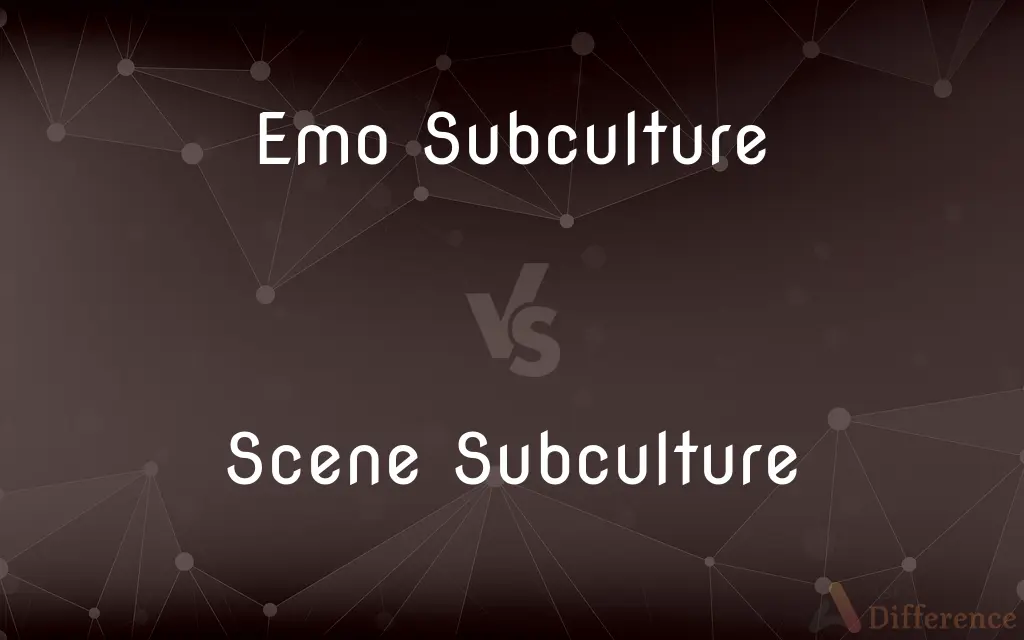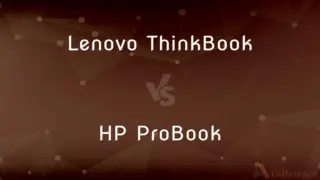Emo Subculture vs. Scene Subculture — What's the Difference?
By Tayyaba Rehman — Published on January 27, 2024
Emo subculture is associated with emotional expression, introspective music, and a distinct fashion style often featuring dark colors. Scene subculture is related to vibrant fashion, a blend of music styles, and a more outgoing social demeanor.

Difference Between Emo Subculture and Scene Subculture
Table of Contents
ADVERTISEMENT
Key Differences
Emo Subculture: Originating in the 1980s, emo is closely tied to a genre of music that emphasizes emotional and confessional lyrics, often dealing with themes of sadness, introspection, and angst. Scene Subculture: The scene subculture, emerging in the mid-2000s, is more eclectic, combining elements of emo, punk, and pop, with music that is often energetic and synth-heavy.
Emo Subculture: Fashion in the emo subculture includes skinny jeans, band T-shirts, studded belts, and dark-colored hair, often styled with long, sweeping fringes. Scene Subculture: Scene fashion is characterized by bright, neon colors, skinny jeans, band tees, and distinct hairstyles with bold streaks and choppy layers.
Emo Subculture: Emo subculture is known for its introspective and sometimes melancholic demeanor, with a focus on emotional authenticity. Scene Subculture: In contrast, scene subculture is often perceived as more outgoing and flamboyant, with an emphasis on individualism and a vibrant social presence.
Emo Subculture: Emo is often linked with a sensitivity to emotional experiences and a strong connection to specific types of alternative music. Scene Subculture: Scene subculture is more associated with a mix of music tastes, from electronic to pop-punk, and an active online presence, especially on social media platforms.
Compare with Definitions
Emo Subculture
It features a distinct fashion style with dark colors and skinny jeans.
Emo fashion includes black band t-shirts and skinny jeans.
ADVERTISEMENT
Scene Subculture
The subculture emphasizes individualism and a strong online presence.
Many in the scene subculture are active on social media platforms.
Emo Subculture
Emo emphasizes emotional expression and authenticity.
Poetry and introspective lyrics are significant in emo culture.
Scene Subculture
Scene subculture is known for its eclectic blend of music styles.
The scene subculture enjoys a mix of electronic, pop-punk, and emo music.
Emo Subculture
Emo subculture is associated with emotional, introspective music.
Bands like My Chemical Romance are often linked with the emo subculture.
Scene Subculture
Scene is associated with an outgoing and flamboyant social demeanor.
Those in the scene subculture often have a vibrant and outgoing personality.
Emo Subculture
The subculture has its roots in the hardcore punk movement of the 1980s.
Emo evolved from the hardcore punk scene of Washington, D.C.
Scene Subculture
Scene emerged in the mid-2000s, influenced by elements of emo and punk.
Scene culture developed as a more vibrant offshoot of the emo movement.
Emo Subculture
Emo is often characterized by a more introspective and less flamboyant demeanor.
Members of the emo subculture are known for their introspective and emotional nature.
Scene Subculture
It features vibrant fashion, including neon colors and bold hairstyles.
Scene fashion often involves neon-colored hair and flashy accessories.
Common Curiosities
Are emotional expression and introspection key elements of the emo subculture?
Yes, emotional expression and introspection are central to the emo subculture.
How do scene and emo subcultures differ in fashion?
Emo fashion typically features darker colors and a more somber style, while scene fashion is characterized by bright colors and flamboyant hairstyles.
Can someone be part of both emo and scene subcultures?
While the two have distinct characteristics, individuals may find aspects of both subcultures appealing.
How has the emo subculture evolved over the years?
The emo subculture has evolved from its hardcore punk roots to incorporate a wider range of musical and fashion influences.
Are the emo and scene subcultures still active today?
Yes, both subcultures continue to have active communities, though they have evolved over time.
What music genres are popular in the emo subculture?
Emo music, alternative rock, and punk-influenced genres are popular in the emo subculture.
What is the typical demeanor of someone in the emo subculture?
Individuals in the emo subculture often exhibit a more introspective and emotional demeanor.
What role does fashion play in these subcultures?
Fashion is a key component in both subcultures, serving as a form of self-expression and identity.
Do scene subculture members engage more in social media?
Yes, the scene subculture is known for its active and vibrant presence on social media platforms.
Do both subcultures share a love for specific music genres?
Yes, both subcultures enjoy alternative and punk-influenced music, though the scene subculture also embraces elements of electronic and pop-punk.
How do emo and scene subcultures express individualism?
The emo subculture expresses individualism through introspective lyrics and personal style, while the scene subculture does so through vibrant fashion and social media presence.
What is the historical origin of the emo subculture?
The emo subculture originated from the hardcore punk scene of the 1980s, particularly in Washington, D.C.
Is the scene subculture considered more flamboyant than emo?
Yes, the scene subculture is generally considered more flamboyant and outgoing compared to emo.
How important is music to the emo and scene subcultures?
Music is central to both subcultures, providing a foundation for their beliefs, attitudes, and expressions.
Has the scene subculture influenced mainstream culture?
Yes, elements of the scene subculture, especially its fashion and music, have influenced mainstream culture and trends.
Share Your Discovery

Previous Comparison
38 Special vs. 380 Auto
Next Comparison
Lenovo ThinkBook vs. HP ProBookAuthor Spotlight
Written by
Tayyaba RehmanTayyaba Rehman is a distinguished writer, currently serving as a primary contributor to askdifference.com. As a researcher in semantics and etymology, Tayyaba's passion for the complexity of languages and their distinctions has found a perfect home on the platform. Tayyaba delves into the intricacies of language, distinguishing between commonly confused words and phrases, thereby providing clarity for readers worldwide.













































